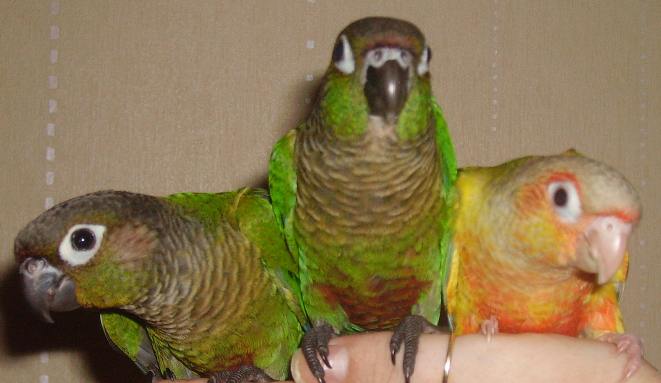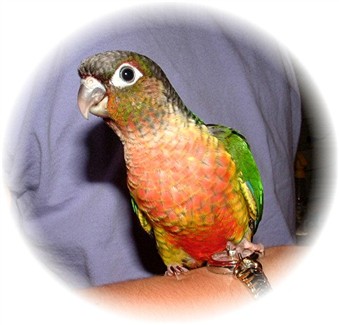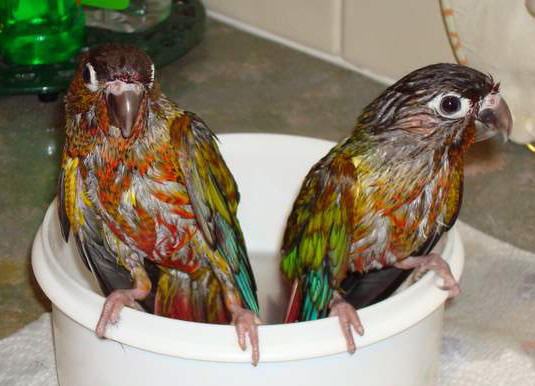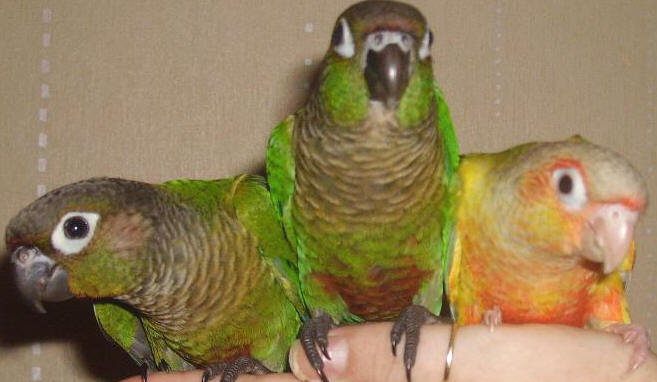
|
 |
BREEDS
& Their NEEDS
Yellow-Sided Green-Cheeked
Conures
(Pyrrhura hypoxantha
)

|
 |
|
Green-cheek &
Pineapple Babies |
 |
 |
 |
Red
Yellow-sided Conure |
Yellow-Sided
Green-Cheeked Conures
(Pyrrhura hypoxantha
)

(Click to see Egg Incubation Chart - a quick way to see when eggs are due to hatch)
- These are a
beautiful mutation of the Normal Green-cheek Conure (Pyrrhura
Molinae)
- Found in the wild - in
the forests, fields and farmland of Brazil, Bolivia,
Uruguay, Paraguay and N.W. Argentina.
Interesting
FACTS
- A man named
Forshaw first spotted the
Yellow Sided Green-cheek mutation in the wild
-
he thought it was a separate
species.
- He named them
Pyrrhura hypoxantha
or "Yellow-sided Conure".
- It wasn't until this
mutation was imported with other Green Cheeks from the wild that
it was determined
not to be a separate species.
- The first Yellow Sided Green Cheeks
were imported in the early 1980’s thru a
quarantine station.
- They
tried breeding these first
Yellow Sided conures to try and work out how
the mutation was carried genetically.
- It wasn't even certain
at first if it was a mutation or a sub-species.
- It was all further
complicated by all these first Yellow-sided being females only.
-
A similar problem occurred
when first trying to establish the Pineapple mutation.
- They had to line-breed
for several generations to produce male Yellow-sided.
- Green-cheeked Conures have oil
glands they use to preen their feathers
- So,
do not create the
dust normally found on Cockatiels, Cockatoos, and African Grey Parrots.
So,
Allergy sufferers may be able to keep one - a big plus point for
them!
- They can live to 20+ years old
- They can learn to talk but have rather
a squeaky "voice" compared to for example an A. Grey
- Noise levels: as per most
Pyrrhura Conures (i.e. Green-cheeks, Maroon Belled etc.) is no worse than cockatiels
- But still noisy compared to Kakis and
Rosellas - a more harsh call!
- Unlike the Aratinga Conures who
are, in the main, very loud and noisy. i.e. Sun Conures
.JPG)
- approx. 8 - 10" in
length
- 60-90 grams (2-3oz) in
weight
- The are
capable of breeding from 1year+
- They can be
kept happily in a colony when not breeding
- But only ONE
PAIR per AVIARY when Breeding as the Cock birds can become
aggressive and possessive.
- They do say that it's best to have
other conures within earshot to help stimulate them into breeding
- A bit like budgies like to be in
colonies and like noise - as well as making it!
- If you do have pairs in adjoining
Aviaries it's best to have double mesh with a min of 1" between
the mesh.
- Also, if you have the Nest boxes on the
mesh side of the adjoining Aviary, between the 2 pairs
- - put a piece of Plywood on the other
side of the mesh blocking the view to the Nest site area,
- so the birds using the Nest box do not
feel threatened and spend 1/2 their time chasing off "potential
competitors" instead of getting on with the business in
hand i.e. breeding, feeding the hen/chicks !
- They do not
need extra heat (even tho some Breeders do pamper theirs with
extra heat in very cold weather).
- They usually start to breed in winter months
(end of Nov - Dec/Jan) but must have suitable
shed or sheltered
area to nest
and/or roost in and be
well-protected from the elements, esp. draughts.
- A lot of Breeders use lighting on
timers to lengthen the daylight hours during the dark winter
months.
- This emulates more spring-like
conditions and stimulates the birds into "Breeding mode".
- They can lay their first round through December, hatching their first young in January
(or earlier).
- This seems to be quite normal, as I
found out when looking for a pair
- None were available (first week of Jan)
as they had mostly gone down on eggs or already had chicks
^Top
FEED
- You can buy a
specially prepared Conure mix but this does tend to more
expensive than mixing your own.
- You can also
buy a special Pelleted mix, which incorporates correct
levels of protein and added vits and mins.
for Conures.
- Versele Laga do a Pelleted Conure Mix.
- SEED
makes up approx 60% of the Conure Diet (not too many sunflower
seeds as very fattening and addictive)!
- The rest is
made up from a mix of: Peanuts, Paddy Rice, Safflower seeds,
small Pine Nuts, Groats, Pinhead Oatmeal, Hemp - good at
breeding time to help bring the birds into breeding condition +
a little Niger - high oil content - birds seem to relish these
seeds.
- Niger is also found in
most proprietary Egg food mixes - they are the skinny black seeds.
- they also like a little bit of
finely shredded chicken (protein) good during breeding
season.
- MILLET SPRAYS
are relished - do not feed too often, as can be quite fattening
- Very useful
when feeding young tho as they are easy to digest and feed
to the babies
- (u can soak first to make them even easier to
digest when feeding the young)
- If you do soak - make sure you remove
any uneaten ones every day as they can go mouldy.
- they will benefit
from having access to Egg-food regularly, even when not breeding x1
or x2 per week
- When Breeding
Egg-food should be provided every day x1 or x2
- I like Rob
Harvey's Witte Mollen
(it smells good, has a decent protein
value, stays moist and crumbly,
so you don't have to add water and the birds
love it and do well on it).
- It's quite
expensive but he tends to have "Show Offers" when you buy at
Stafford etc., and you can also buy
refill packs, cheaper again. (£12 per 5kg refill pack from Stafford Oct '09)
- Cuttlefish,
pink Iodine Nibbles and mineralised Grit/Oystershell Grit should
be available at ALL TIMES
to provide essential calcium, minerals
and iodine.
- Esp. important
to have free access to all the above at breeding time to ensure
the birds' calcium levels do
not fall when laying eggs, otherwise calcium can be extracted from
the hen's bones - not good.
FRUIT & VEG
Conures tend to prefer Fruit to Veg - Rosellas tend to prefer Veg to
Fruit!!
- Conures love most
Fruit so make sure you give some on a Daily basis
- Favourites
include: apple, orange,
Grapes (their favourite
fruit esp. Red ones) +
mango,
broccoli, celery,
dandelion leaves,
chickweed, Willow twigs + leaves (make sure these come from a clean source
- if it's from the kerbside make sure you know
it hasn't been
sprayed with weed-killer - always wash first).
- Vegetables
: spinach, kale, sweet
potatoes, frozen
cooked sweetcorn,
carrot, will be nibbled at but not
relished in quite the same way they love Fruit
- When the season is right (Autumn - they
also love Mountain Ash berries, Elderberries, Blackberries
- the latter 2 make a bit of a mess - so poss avoid if you keep
your birds indoors!!
- Remember
Conures are prone to "Conure
Bleeding Syndrome"
3click on link
- So need plenty
of foods high in iron & Vit K. (which
is the anti-dote for bleeding) i.e.
most dark green veg.
- They also love Mountain Ash berries, Elderberries, Hawthorn berries and Rats Tails (Plantain) + Willow fronds with leaves and Eucalyptus sprigs.
- The more (clean) wild foods you feed your birds, the better.
FOODS TO AVOID - Toxic to
your birds' health
- Seeds : Apple, cherries, peaches, apricots,
and pears Seeds contain trace
amounts of
Cyanide!
- Remove the cores/seeds before you
offer to your birds -- these fruits are o.k.
it's just the seeds!
- Make sure you wash the fruit before
offering bits with skin on if they have come from an unknown
source
- i.e. not from your own or known
fruit trees - just in case they have been sprayed with
insecticides.
- Avocado : Both skin and stone
have been known to cause cardiac distress and eventual heart
failure in
most Pet bird species.
- Mushrooms
(fungus) - have been known to cause
digestive upset in Pet birds.
- Caps and stems of some varieties
can effect the Liver.
- Tomato
like Potatoes are
o.k. to offer to your birds - not greatly relished by most
birds.
HOWEVER:
- The stems, vines, and leaves,
however, are highly toxic.
- Make sure that any time you offer
your bird any tomato it has been properly washed
- ALL green parts must be removed
first, as these are the parts that are toxic to your birds
- Chocolate : Chocolate poisoning
first affects a bird's digestive system,
- causing vomiting and diarrhoea.
- If the condition progresses, the
bird's central nervous system is affected,
- causing seizures and eventually
death if not caught in time and treated by an Avian Vet
- A VERY GOOD
REASON NOT TO Offer Choccy biccies to your pampered
pets!!
- Dried Beans :
- Cooked beans or soaked, sprouted Beans
are safe to feed, have good feed value and are enjoyed by lots
of Birds
- but raw, dry bean mixes can be
extremely harmful to your pet.
- Uncooked beans contain a poison called
haemaglutin, which is very toxic to birds.
- Make sure you thoroughly cook any
beans that you feed your birds
- or soak until they sprout and
rinse well b4 feeding.
- Dairy/Milk products : Birds are
"Lactose Intolerant" and lack the digestive enzymes needed to
break down
milk sugar and milk proteins.
- Products such as milk, cream and butter
should not be fed
- but yogurt, cheeses and dried milk can
be used in the diet in moderation (as they are
also high in fat
^Top
SPROUTED /
SOAKED SEEDS / Pulses
- Can
be fed once or twice per week to all birds throughout the year.
- When
Conures are breeding it would be beneficial to feed some every day
- Seeds
change their food values as they start to split and sprout
- They then provide a higher level of protein, vits &
mins than when in their dormant,
normal seed-state
- (i.e.
before they are soaked).
- Soak the mixed
seeds approx 24 hours, put into a sieve - wash by running water
through the sieve
- Keep damp
seeds in a dark place until sprouting occurs -
- it works
better if you can spread them thin rather than have in a
deep container.
- Once they
start to sprout
- Wash again
until you are sure they smell "fresh" - then feed.
- Do not offer
any seeds/foods etc., if they smell even slightly off or rancid.
^Top
WATER
- Fresh water
must be provided at all times in clean dishes or drinkers

- They love to
dunk their food in their water dishes - so to prevent a "Cold
Soup" concoction you must clean
out any open water containers
and refill with fresh water at least once per day.
- Another reason
for having a tube or bottle feeder as well as an open dish they
can dunk and bathe in.
- Conures love
to bathe, so ideally they need a drinker (bottle/tube or small
dish) higher up to drink out of
- plus a bigger
bath/dish to bathe in.
- they will
break water to bathe as will Kakarikis
NESTBOXES:
- IDEAL SIZE :
18 - 24" Deep and 9 - 10" square

- Some Breeders advocate
having the entrance to the nest-box on a 45⁰angle with a shoe
box section
on the end
- This stops the birds damaging the eggs
if the drop down too heavily onto them.
- Birds feel more secure in a deep,
dark, small, neatly-sized space
- - less chance of predators
finding them in the wild or gaining access to the nest site!
- Make yours fairly deep and a
compact-size - never have the base too spacious, as the eggs can roll
away
- this can damages the embryo &/or the eggs can
become chilled
- Best to have a concave base made
out of a piece of thick 1"+ chip-board - this is good for
insulation
- the concave also helps prevent the eggs
rolling away from the hen.
- Use " Easibed" wood chip in the base
- This is primarily a Horse bedding and
as such,
you will find it cheaper in an Agricultural Merchants
or a
Saddlers than in a Pet shop or anywhere it is sold for birds.
- It's dust free and ideal for Aviary
floors too.
- ideally the Nest box
should be made out of 3/4" marine-ply for good insulation
in
the colder weather
yet thick enough to help keep the insides of the Nest box
cool during warmer weather
- Marine-ply, as the name suggests, is
also weatherproof.
- We always put a piece of Aviary
mesh, fixed to the inside of the nest box from just above
the base
to the Pop-hole opening
- - this is to make it easy for both
parents and chicks to climb out when they are ready to fledge.
- the Pop-hole should just be big
enough to accommodate the hens' body if she sits in the
entrance with
her head and shoulders sticking out (approx. 1½"
diam.)
- this gives them the
feeling of security, as predators wouldn't be able to gain
access if the hen
was blocking the entrance hole with her
body and the entrance would also be too
small for the average predator to get in in the wild.
- this just proves that instincts from
living in the wild do kick in when keeping and breeding birds,
so you should try and emulate their breeding conditions
from the wild as closely as possible.
- This follows that all nest boxes
should be positioned as high as possible - height is
important to birds.

- Also,
do NOT face the pop-hole or the Nest box South as during
the hot summer months the nest box would get unbearable hot
inside.
- The chicks could over-heat and even
die (a bit like a dog locked in a car on a hot day with
windows closed)
- Try and face it towards North-East or
South-East.
- A snippet of info. from a
Yellow-sided Conure Breeder:
"Conures don't like a lot
of nest material, mine lay in the corners and the bedding is
pushed to the other side
of the box. I put a few shavings in and bits of wood chips
which they chewed up. These chicks are lying on the bottom
of the box, no bedding underneath them, doing ok. Conures
do sleep a lot in the boxes, mine go straight back in when the
hear me around".
- They can lay
4-8 eggs but the average is 5-6 eggs
- The ideal
humidity for incubation is 50-55% while the hens incubate in the
nest box
- When
incubating artificially in an Incubator - keep at the above
humidity levels until approx 4 days
before they are due to hatch and
then "up" the humidity to maximum i.e. 85-90+%
- This helps the
chick rotate and break out of the shell successfully.
- More chicks are lost by the air
being too dry around the egg and the chick struggles to get
out.
- Incubation
usually 22 - 25 days (average 23days)
- The young
fledge around 7 - 8+ weeks
- They are
usually close Rung at 12 - 14 days with Size P
rings
- (some sites say size N
but size P seem a better fit the size N could be a bit neat).
- Once they
Fledge the hen may go down and lay again
- She is capable
of laying 2 - 3 clutches of eggs per season but never be allowed
to lay any more.
- The Cockbird
continues to feed the youngsters for a further 2 weeks+ in the
Aviary.
- Until they are
fully independent and able to feed and fend for themselves
- At this point,
if there were any problems they could be removed to a Crèche
Aviary
- the Youngsters
can be identified as they are a duller colour to the adults
- They need
to be sexed via DNA - Feather or blood send to "Avian Biotech"
- They also supply PSUK Closed Rings
for your birds. (Avian ID) - same firm as above - diff.
departments.
- Avian
ID, P.O. Box 107, Truro,
Cornwall TR1 2YR
Tel: 01872 262777
:
www.avianid.co.uk
a new one that uses blood is "Polytest"
- Unless you have 2 distinct single
colours (mutations) for parents, then you can sex the
Youngster
as they will be sex-linked : > >
- i.e. a yellow-sided cock paired
with a cinnamon hen
- Then it would follow that all the
youngsters would be easily sexed:
- i.e. all the Hens youngsters would
be yellow-sided
- All the cock-birds would be
visually cinnamon (split for yellow-sided)
OBSERVATIONS - watching a
Breeding pair via a Nestbox Camera
- When I first got my
young pair I thought I'd ended up with 2 hens cos they'd started
to "work the nest box",
- I knew they'd been going in the
Nest box for weeks because of the feathers in there
- But I think they must sleep/rest in
there as normal.
- First signs of impending
breeding/egg laying is when they start to "work the box"
- which they do
by scraping the bedding up to leave one corner nude of
bedding.
- they lay their eggs in the cleared
area - so not really sure why we put bedding in
- - unless it just stops the eggs
from rolling forward.
- the cockbird went
into the nest and just sat as if it was a hen ready to lay - not
working the box - just sitting.
- That's why I thought I had 2 hens, as the hen was out in the Aviary and he was in the box as if he was "ready to lay" - which obviously he wasn't!!
- I could watch what he was doing on the security cameras
- The following day the hen was in and
laid her first egg -
- So my theory was that the cockbird
was just "keeping the bed warm for his pregnant wife"!!
- I also saw them mating
in the box mid-lay i.e. she'd laid 2 eggs and then she was in
sitting and he was later mating with her.
- The cockbird feeds her in the box.
- He does sit with her but mostly is
either in the Aviary eating and keeping watch or often inside
the box but sitting with his head out of the pop hole keeping
watch.
- My hen does seem to come off the eggs
as soon as she hears a loud
noise - she goes back fairly quickly but it worries me that the
eggs may cool and not form properly
- Time will tell > it turned out not to be a problem - all the eggs were fertile and all hatched on time.
- Both these birds are
"First-timers" the cock is 17months old and the hen is
14months old.
- Another sign of impending egg-laying (with most birds) is
when the hen's dropping become copious, loose
and sloppy
COLOURS

- Pineapple
Conures, which are a lovely orangey variation on the
Yellow-sided are produced by :
- Combining the
Yellow-sided and the Cinnamon colours
- Other Mutations of the
Green-cheeks are:
- Blue Pineapple, Olive (Misty)
Green-cheeked, Blue Yellow-sided, Blue Cinnamon &
Pied Green-cheeked.
2 Green-cheeks +
Pineapple
- It's the hen's genes that
determine the sex of the youngsters
- With a Hen - "What u see
(colour-wise) is what you get"
- By that I mean is - even if
the hen's parents were a yellow-sided mum and a
normal-green-cheek dad - the hen is
visually a normal Green-cheek colour (same colour as her
dad).
- She has yellow-sided in her genetic
make-up (from her mother) but this colour gene will only be
passed on to any sons she has, who may then have the yellow-sided genes
passed from her and therefore be
"Split for yellow-side"
- However, the sons will usually
still be visually a normal Green-cheek (the same colour as
the mum) but will carry the Grandmothers' yellow-sided gene
and may pass this on to some of it's
off-spring, depending on what colour hen the son is paired
with.
- So, even tho the hen has yellow-sided in her
breeding she cannot produce yellow-sided
colours unless she is paired to a Cock with Yellow-sided in
it's Breeding.
- the cock can either be
visually a yellow-sided or a visual normal Green-cheek split
to yellow-sided.
- In other words the Cock
birds carry the Colour Genes, so even if the cock is
visually a normal
green-cheeked colour, if it's parents or
even grandparents were different colours, it can carry these
colours in its genetic make-up and these colours will eventually
show up in it's offspring somewhere along the line.
- So the Cock birds are responsible
for the visual colouration of the off-spring.
- the Hens however can be
any colour you like but unless they are paired up to a
cockbird of the same colour or split for that colour - no
chicks will be visually that colour - the young cocks can
have the hens' colour gene passed onto them and can then be
split for that colour but will not necessarily be that
visual colour
SEX-LINKED COLOURS
- The easiest way to try and get your
head round this is to remember:
- When Breeding:
- The Young Cock birds are usually the
same colour as the Hen (mum)
- The Young hens resemble the
Cock birds visual colour or a colour carried by the Cockbird in
it's
genetic make-up.
- Put simply - In general :the
young hens resemble the dads and the young cocks resemble
their mums.
- It's the Cock's that
dictate the visual colouration of the youngsters
- the Cock can be split for
more that one colour and these are the colours that are
visual
- So you can get a split
(carries 2 colourations) or a double-split cock (carries 3
colourations)
CINNAMON MUTATION
-
The Cinnamon mutation is sex-linked and is well
established in the UK.
-
A Cinnamon bird can't produce black or grey
in any colour shade.
-
Newly-hatched Cinnamon Green-cheeked
are easily
recognized by plum-coloured eyes that darken
as they get older.
^Top
Link to a good site:
www.conures.co.uk
 |


